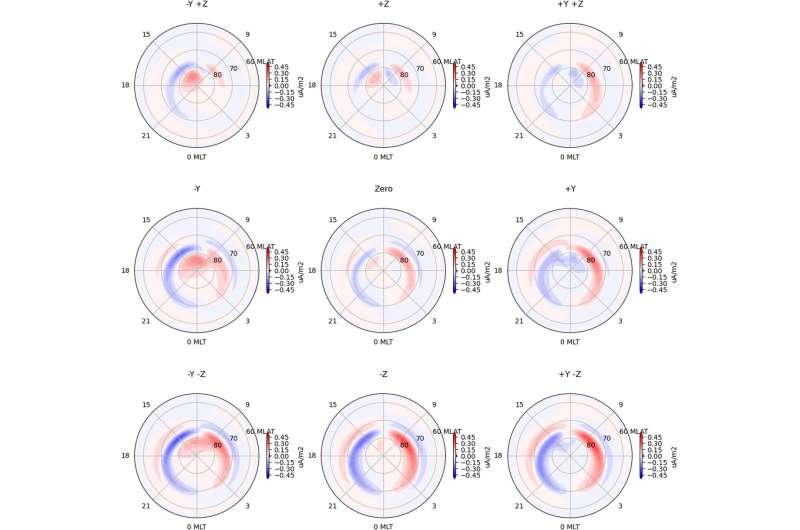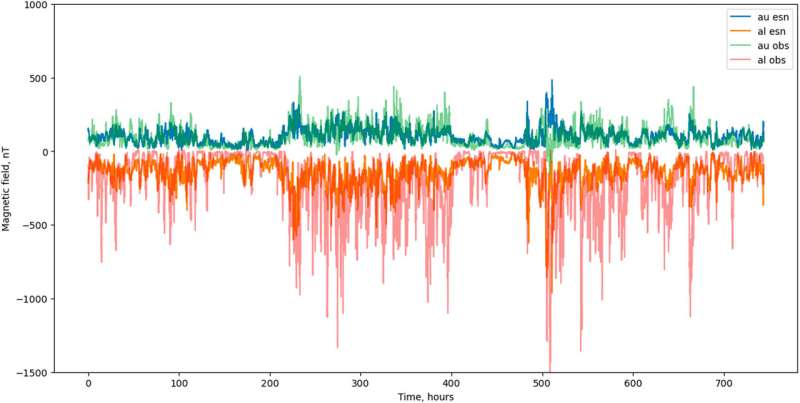This article has been reviewed according to Science X's editorial process and policies. Editors have highlighted the following attributes while ensuring the content's credibility:
fact-checked
peer-reviewed publication
proofread
Researchers leverage machine learning to improve space weather predictions

There are three levels of severity for space storms: geomagnetic storms, solar radiation storms and radio blackouts. These storms produce different effects on Earth, including satellite, GPS, communications and electrical grid issues, as well as health dangers for astronauts and people on high-altitude flights. Geomagnetic storms also produce the beautiful auroras that are commonly observed in polar regions.
Because of the potential negative effects of space storms, researchers have developed physics-based models that predict the auroral current system based on the incoming solar wind particles ejected from the sun.
Up to this point, however, such models were slow and required an entire supercomputer to run. Researchers have now created a machine learning-based emulator that mimics physics-based auroral current system simulations much more quickly and with less computing power.
The team published the results of their study in the journal Space Weather.
"A physics-based simulation of the auroral current system is an option for the space weather forecast. However, we need a designated supercomputer for running the physics-based simulation," said Ryuho Kataoka, first author of the paper and associate professor at the National Institute of Polar Research and SOKENDAI, both in Tachikawa, Japan.
"One of these models is REPPU (REProduce Plasma Universe), which is a well-known and reliable model that reproduces the auroral current system. Once we created the 'emulator,' we could get similar results using a laptop PC."
The new emulator model, Surrogate Model for REPPU Auroral Ionosphere version 2 (SMRAI2), is a million times faster than the physics-based simulation and incorporates seasonal effects into its modeling.
While solar weather forecasts cannot change the effects of solar radiation and the solar wind particles on and around Earth, it can help communities affected by solar weather prepare for communication difficulties and failures and limit radiation exposure for astronauts and high-altitude aircraft passengers.
Satellites, in particular, are highly sensitive to drag caused by magnetic storms. In fact, 38 commercial satellites were lost in February 2022 due to reentry into the Earth's atmosphere after a moderate magnetic storm. These magnetic storms are the result of a large energy transfer from the solar wind to the Earth's magnetosphere.

The research team used a time-dependent machine learning model called echo state network (ESN) to create the physics-based prediction model emulator. Importantly, ESNs are a type of recurrent neural network designed to efficiently handle sequential data.
The current study actually improved upon an initial version of the ESN-based emulator, ver1.0. The team trained the new emulator model, SMRAI2, using an order of magnitude more physics-based simulation outputs than the original ver1.0 model.
"The product of this study, SMRAI2, is the first example of auroral physics that utilizes a machine learning technique to emulate the ionospheric output of the physics-based global magnetohydrodynamic (MHD) simulation. Accumulating more MHD simulation data and using other cutting-edge machine-learning models will enable us to update prediction accuracy in the near future," said Kataoka. MHD simulations are designed to describe the behavior of the magnetosphere, where the solar wind interacts with the Earth's magnetic field.
The next step for the research team is to incorporate the emulator in running the ensemble space weather forecast, which is a set of forecasts offering a range of future space weather predictions. Their ultimate goal is to use the emulator, together with many observation datasets, in a data-assimilation forecast, which integrates model output and observations to improve prediction accuracy.
More information: Ryuho Kataoka et al, Machine Learning‐Based Emulator for the Physics‐Based Simulation of Auroral Current System, Space Weather (2024). DOI: 10.1029/2023SW003720
Journal information: Space Weather
Provided by Research Organization of Information and Systems





















